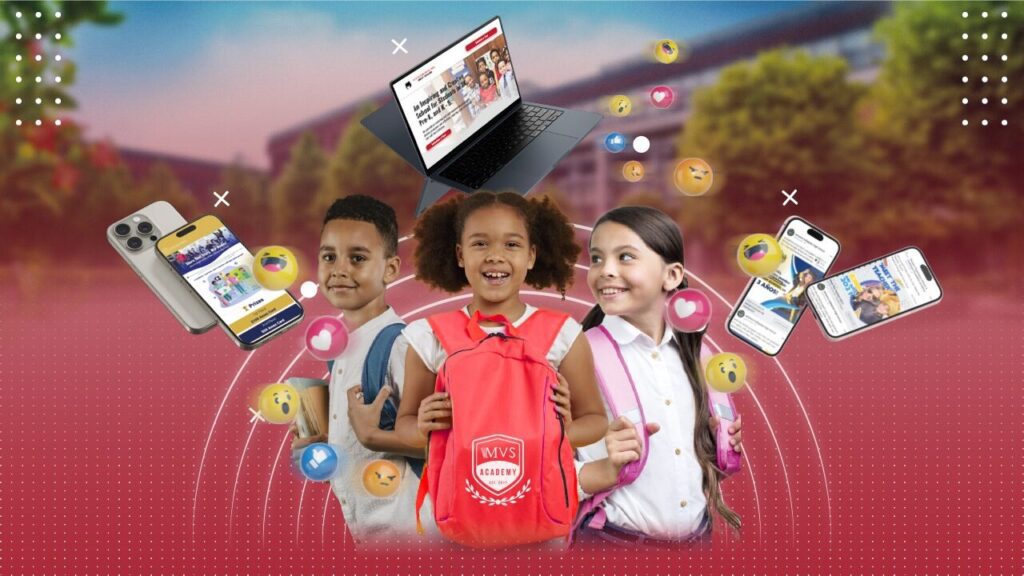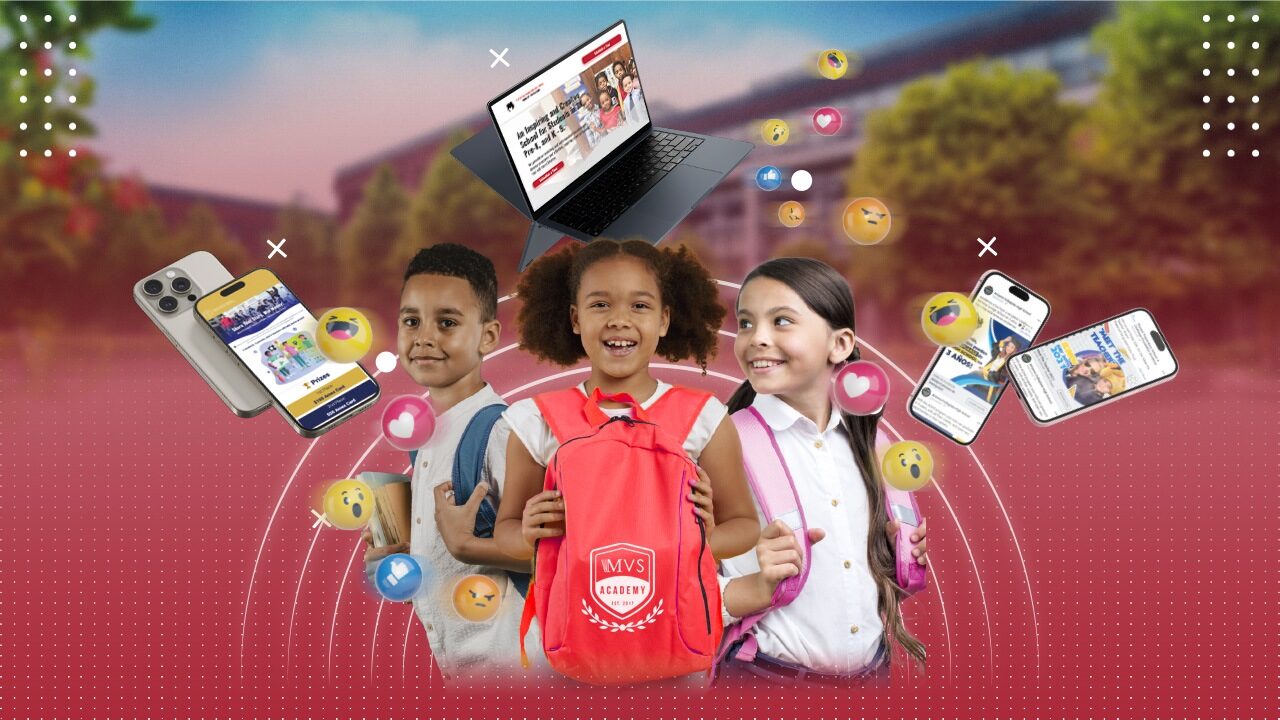In today’s competitive education landscape, schools need a strong image more than ever. It sets them apart, leaves a lasting impression, and attracts the right students and families. In this blog post, we’ll explore how a strong school brand shapes its image and success, and provide key strategies on how to create a strong school image.

Everything you Need to Know About School Branding and Image
So, what exactly is branding and why do schools need it? Branding is the strategic development and implementation of a set of guidelines and visual elements that work together to maintain a consistent and positive image, one that accurately reflects the school’s values, culture, and identity.
When your school consistently uses these brand elements, it creates a cohesive and professional image that is easily recognizable to students, parents, staff, and the community.
This comprehensive guide will cover everything you need to know about branding and creating your school’s image.
Why is Branding Important for Schools?
Imagine you’re in a supermarket aisle, faced with two brands of cereal. One has a vibrant, eye-catching package with a well-known mascot, while the other is in a plain box with no distinct features. Which one are you more likely to pick? The one that resonates with you, the one that you recognize and trust.
Similarly, when parents or students are choosing a school, they’re not just looking for an educational institution; they’re looking for a community that aligns with their values, aspirations, and expectations. They want to know if the school’s ethos matches their own philosophy towards education and personal development. Is the school progressive or traditional? Does it prioritize academics over extracurriculars, or is it a balanced approach? These are questions that branding can help answer even before a prospective student sets foot on campus.
The importance of school branding cannot be underestimated. It creates your school’s image and communicates your mission, vision, and unique selling points.
How to Start Building a Strong School Image
Whether you’re working on your school’s image from the ground up or refining your image, these insights will help you define and communicate the essence of your school effectively. The goal is to create a school image that highlights the great work you are doing and also embraces your community.
Vision: Defining Your School’s Aspirations
Start by asking, “What do we want our school to be known for?” Your vision is the north star, guiding everything from academic excellence to community involvement. It’s the big dream that your school is striving towards.
Mission: The School’s Purpose
Your mission answers “What is our school’s purpose?” It’s a clear statement that defines the objectives and approach of your school. Whether it’s fostering innovative learning or nurturing future leaders, your mission is the ‘why’ behind your school’s existence.

Values: The Core Principles
Values are the bedrock of your school’s culture. They answer, “What are the principles guiding us?” These could include integrity, inclusivity, or collaboration. Your values set the tone for how the school operates and interacts with its community.
Personality: The School’s Unique Character
Every school has a personality. Is your school innovative, traditional, artistic, or tech-focused? This personality makes your school relatable and distinct. It’s the unique flavor that sets your school apart.
Action and Audience: The What, Why, and Who
Finally, consider what your school does, why it does it, and who it’s for. This encompasses your educational offerings, teaching approach, and your target community. It’s about aligning your actions with your vision, mission, values, and personality.
In conclusion, building a strong school image is a strategic journey that starts with clarity in your school’s vision, mission, values, and personality. Begin by articulating what makes your school unique and what you aspire to be known for. Ensure your mission reflects the core purpose of your institution, and let your values guide every decision and interaction. Embrace the unique character of your school, and align your actions and messaging to resonate with your intended audience.
Ready to Craft Your School’s Message?
The Visual Identity of a School
In the digital age, where visuals often speak louder than words, the visual identity of a school plays a pivotal role in shaping perceptions and building connections. Let’s dive into the intricacies of this essential aspect of school branding.

What is the visual identity of a school?
At its core, a school’s visual identity is the collection of visual elements that represent and communicate the essence of the school. It’s the face of your institution, the first impression, and often the lasting memory people have of your school.
Why is the visual identity of a school important?
Visual identity goes beyond just aesthetics. It’s a powerful communication tool that conveys your school’s values, culture, and ethos without uttering a word. In a world where people are inundated with information, a strong visual identity helps your school stand out and be instantly recognizable.
First things first, you need a school logo. Once you’ve got your logo, it’s wise to create a brand style guide. Your brand style guide will cover everything from logo usage, typography, colors, and the tone and voice you use. Basically, your brand style guide is a playbook to ensure your visual identity is represented consistently across various mediums and platforms.
What are the benefits of a strong school visual identity?
A cohesive and compelling visual identity:
- Enhances recognition and recall among stakeholders.
- Builds trust and credibility.
- Fosters a sense of community and belonging.
- Amplifies the school’s reputation and prestige.
- Streamlines communication efforts.
- Elements of a School Visual Identity
The Core Elements of a School’s Visual Identity
Your school’s visual identity is reflected through the logo, colors,typography, and imagery that you use.
Logo: The cornerstone of your visual identity. Your school logo should be a unique emblem that encapsulates the spirit of your school.
Colors: Colors evoke emotions and set the mood. Whether it’s the calming blues, energetic reds, or trustworthy greens, your school’s colors should be chosen with care and used consistently to maintain a unified look and feel.
Typography: The fonts you choose play a subtle yet significant role in conveying your school’s personality. Whether it’s classic serifs for a traditional touch or modern sans-serifs for a contemporary vibe, consistency is key.
Imagery: Photos, illustrations, and other visual assets should be of high quality and resonate with your audience. They should capture the essence of school life, the joy of learning, and the bonds formed within the school community.
While these fundamentals provide a starting point, developing an effective and enduring visual identity requires a deeper dive into the nuances of design. Learn how to create your own brand style guide below, or, let Más Vale Saber create it for you!
Tips for Creating a Strong School Visual Identity
A school’s visual identity is a blend of art and strategy, aesthetics and values. So remember that every color, font, and image is a chapter in your school’s grand narrative. Make it count!
Be consistent: Whether it’s a brochure, website, or school banner, ensure uniformity in the use of logos, colors, typography, and imagery. Consistency breeds familiarity.
Be unique: In a sea of educational institutions, your visual identity should set you apart. Avoid generic symbols and clichés.
Be memorable: Aim for a visual identity that’s not just seen but remembered. It should leave an indelible mark on the viewer’s mind.
Be representative: Every visual element should be a reflection of your school’s ethos. It should tell your story, embody your values, and showcase your personality.
Promoting School Spirit and Community
You can strengthen your school’s image by utilizing merchandise, promotional products, and mascots to engage with the community. These elements are key in bringing together students, staff, and families, enhancing a sense of unity and pride around your school.

What are the benefits of a strong sense of school community?
A strong school community offers numerous benefits, including:
- Improved student engagement and academic performance.
- Higher levels of staff satisfaction and retention.
- Enhanced parent involvement and support.
- A positive, inclusive culture that attracts new students and families.
How can merchandise and promotional products help to promote school spirit and community?
Merchandise and promotional products serve as tangible reminders of the school community, creating a sense of unity and belonging that extends beyond the classroom walls.
- Unity and Belonging: High-quality merchandise can act as a unifying symbol for students, staff, and alumni, making them feel part of something bigger.
- Promoting Spirit: Custom merchandise can electrify the atmosphere at sporting events, spirit days, and other school gatherings, amplifying pride and enthusiasm.
- Fundraising: Selling school merchandise can be an effective way to raise funds for school programs, clubs, or community service projects.
Want to boost school spirit with meaningful merchandise? Read about Creative Ways Merchandise Can Enhance School Spirit and Unity.
The Role of Mascots in School Image and Culture
Mascots play a crucial role in shaping and reinforcing the image and culture of a school. They are not just entertaining figures but powerful symbols that represent the spirit and identity of the institution. Let’s look at how mascots contribute significantly to various aspects of a school’s environment, from fostering a unique identity to enhancing school spirit and traditions.
- Unique Identity: A mascot serves as a memorable symbol that sets your school apart from the rest.
- Community and Spirit: Mascots can be rallying points that bring everyone together, from the youngest students to alumni who graduated decades ago.
- Values and Traditions: A well-chosen mascot can embody the values and traditions that your school holds dear.
- Inspiration: Mascots can serve as motivational figures that encourage students to strive for excellence.
- Fun Factor: Mascots add a layer of fun and excitement to school events, making them more engaging and memorable.
For an effective and memorable school mascot, consider these key tips:
- Ensure it reflects your school’s identity and values
- Make it visually appealing
- Maintain consistency across various platforms
- Create a unique backstory with personality traits.
Additionally, involve your school community in mascot-related activities for greater engagement. Dive deeper into these strategies in our comprehensive post, Designing a Mascot that Captures Your School Spirit. This guide offers detailed insights to bring your school’s mascot to life in a way that resonates with everyone.
In closing, enhancing school spirit and community through the strategic use of merchandise, promotional products, and mascots is an important step in strengthening your school’s branding. A strong school community leads to better student engagement, higher staff satisfaction, and increased parental involvement, all contributing to a positive educational environment.
Visual Storytelling
In a world where a picture is worth a thousand words, visual storytelling has become an indispensable tool for conveying your school’s ethos and values. But what exactly is visual storytelling, and how can schools leverage it effectively? Let’s explore.
What is Visual Storytelling?
Visual storytelling is the art of using images, graphics, and other visual elements to convey a message or tell a story. It’s about creating an emotional connection and making complex ideas easier to understand, all through the power of visuals.
Why is Visual Storytelling Important for Schools?
Visual storytelling serves as a compelling medium to express your school’s unique image, values, and culture. It captures attention, fosters engagement, and can be a powerful tool for both internal community building and external marketing.
How Can Schools Use Visual Storytelling to Convey Their Ethos and Values?
By strategically incorporating visual elements into your school’s communications—be it the website, brochures, social media, or even the school environment—you can create a cohesive and impactful narrative that resonates with your audience.
The Elements of Visual Storytelling
- Imagery: High-quality, relevant images are the backbone of visual storytelling. Whether it’s a candid shot of a student engrossed in a science experiment or a panoramic view of your campus, the images should evoke emotion and be aligned with your school’s ethos.
- Composition: The arrangement of visual elements can significantly impact the story you’re telling. Techniques like leading lines, symmetry, and framing can add depth and dynamism to your visuals.
- Color: Colors aren’t just decorative; they carry emotional weight. Bright colors might convey energy and enthusiasm, while muted tones could suggest calmness and sophistication. Choose a palette that reflects your school’s character.
- Text: While visuals capture attention, text provides context. Use it sparingly but effectively to enhance understanding, clarify messages, or highlight key points.
Tips for Using Visual Storytelling to Convey Your School’s Ethos and Values
- Be Authentic: Authenticity is key. Your visuals should genuinely represent your school’s culture and values, not an idealized or generic version.
- Be Consistent: Consistency in visual elements—like color schemes, types of imagery, and text styles—creates a unified narrative that strengthens your brand identity.
- Be Creative: Don’t be afraid to think outside the box. Experiment with different formats, compositions, and visual techniques to keep your storytelling fresh and engaging.
- Be Engaging: The ultimate goal is to resonate with your audience emotionally. Choose visuals and narratives that are not only aesthetically pleasing but also evoke the feelings you want to associate with your school.
As you navigate the complex landscape of school branding and identity, remember that visual storytelling is more than just a buzzword. It’s a powerful strategy to convey who you are and what you stand for, all while engaging your community in a meaningful way.
School Rebranding Considerations
Rebranding is a strategic initiative aimed at reshaping perceptions, redefining goals, and resonating with the community.
When it comes to rebranding a school’s image, it’s important to consider the unique challenges and opportunities that this environment presents. A school’s image is deeply intertwined with its traditions, values, and community. Therefore, any rebranding effort must respect these elements while also aligning the school with the future of education.
When to Rebrand a School
- Outdated Image: If your current image feels like a relic from the past and doesn’t resonate with today’s students and parents, it’s time for a refresh.
- Merger or Restructuring: Significant structural changes, like a merger with another school, often necessitate a new brand identity that reflects the new entity.
- Expansion: If your school is venturing into new markets or introducing new programs, a rebrand can help you effectively target these new opportunities.
- Reputation Management: A rebrand can be a powerful tool for improving or changing the public perception of your school.
- Facing Competition: In a crowded educational landscape, a rebrand can help you stand out from the competition.
Why Rebrand a School?
Rebranding a school offers several key benefits, including enhanced awareness and reputation, which make the school more attractive to prospective students and staff. It also allows for differentiation in a competitive education market by emphasizing unique qualities.
Additionally, a rebrand provides an opportunity to realign and clearly communicate the school’s core mission and vision through its image, ensuring they resonate effectively with the school community and stakeholders.
Challenges in Rebranding a School
- Stakeholder Buy-In: One of the biggest hurdles is getting all stakeholders—students, parents, staff, and alumni—on board with the change.
- Authenticity vs. Aspiration: Striking the right balance between who you are and who you want to be can be challenging.
- Implementation: Consistently applying the new brand across all channels requires meticulous planning and execution.
- Measuring Success: Determining the ROI of your rebranding effort can be complex but is crucial for understanding its impact.
Rebranding is not a task to be taken lightly. It’s a strategic endeavor that requires careful planning, execution, and monitoring. But when done right, it can breathe new life into your school, aligning it more closely with your goals and the needs of your community. Before you start, read our Tips for Rebranding Your School.
Key Takeaways
We’ve covered a lot of ground in this comprehensive guide on school branding and image. From understanding the basics to diving into the nitty-gritty of visual storytelling, style guides, and even rebranding, it’s clear that creating a strong school image is both an art and a science.
Here are some key takeaways to keep in mind as you embark on or refine your school’s branding journey:
- Importance of Branding: A strong image is not just a luxury; it’s a necessity in today’s competitive educational landscape. It helps in building trust, fostering community, and achieving your school’s mission and vision.
- Start with the Basics: Your school’s image is not just about a logo or a tagline. It encompasses your vision, mission, values, and the unique personality that sets you apart. Make sure these elements are clearly defined.
- Merchandise and Mascots: These elements can serve as tangible extensions of your brand, fostering school spirit and community engagement. They can also be effective tools for fundraising.
- Brand Style Guide: This is your branding bible. It ensures consistency across all platforms and touchpoints, making it easier for your staff to produce on-brand content and protecting your school’s image.
- Measure and Adapt: The work doesn’t end once a strong image is established. Regularly measure its effectiveness through key performance indicators like brand awareness, website traffic, and stakeholder engagement. Be prepared to adapt and evolve.
We specialize in logo creation, brand style guides, promotional products, and marketing materials. Ready to get started? Let us know!
In closing, remember that your school’s image is more than just a visual identity; it’s the emotional and psychological relationship you have with your stakeholders. It’s the story that people tell about you, the experience they have with you, and the memories they form with you. So make your story a compelling one, told consistently across all chapters, from your logo to your classrooms to your digital presence.




